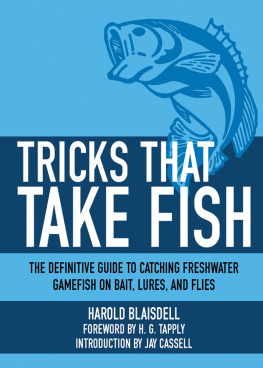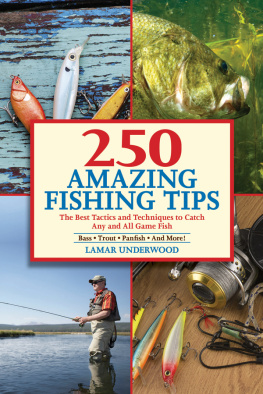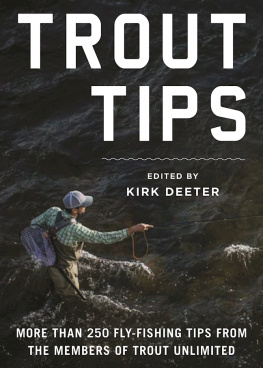 The Freshwater Angler
The Freshwater Angler FISHING
TIPS & TRICKS
More than 500 Guide-tested Tips for Freshwater and Saltwater
C. Boyd Pfeiffer


C. Boyd Pfeiffer, an award-winning outdoor journalist and photographer, has been published in more than 70 magazines, including Saltwater Fly Fishing, Outdoor Life, and American Angler. He has authored 24 books on fishing and outdoor photography. He lives in Phoenix, Maryland.
To Brenda

Copyright 2008, 2011
Creative Publishing international, Inc.
400 First Avenue North, Suite 300
Minneapolis, MN 55401
1-800-328-3895
www.creativepub.com
All rights reserved
President/CEO: Ken Fund
VP Sales/Marketing: Kevin Hamric
Publisher: Bryan Trandem
Acquisition Editor: Barbara Harold
Production Managers: Laura Hokkanen, Linda Halls
Creative Director: Michele Lanci-Altomare
Senior Design Managers: Brad Springer, Jon Simpson
Design Managers: Sara Holle, James Kegley
Page Design & Layout: Laura Rades, LK Design, Inc.
Cover Design: Danielle Smith
All photographs Creative Publishing international except those iStockPhotos on pages .
Printed in Singapore
Digital edition: 978-1-61673-289-9
Hardcover edition: 978-1-58923-286-0
10 9 8 7 6 5 4 3 2 1
Library of Congress Cataloging-in-Publication Data Pfeiffer, C. Boyd.
Fishing tips & tricks : more than 500 guide-tested tips & tactics for freshwater and saltwater angling /
C. Boyd Pfeiffer.
p. cm. -- (Freshwater angler series)
ISBN-13: 978-1-58923-408-6 (hardcover)
ISBN-10: 1-58923-408-1 (hardcover)
1. Fishing--North America--Miscellanea. I. Title. II.
Title: Fishingtips and tricks. III. Series.
SH462.P473 2008
799.1097--dc22 2008007057
CONTENTS
INTRODUCTION

Clever fishing tips and tricks have passed from angler to angler for as long as people have fished. The Greek philosopher Aristotle once wrote that a pair of fishermen could net the skate, a flat-bodied bottom fish, if one played music while the other danced on deck.
Most fishing tips, like Aristotles, are of questionable value. Lots of the tips you find in magazines and books have not been thoroughly tested; they may have worked for somebody, but they dont work for you. Many so-called tips are common knowledge to anybody who spends much time on the water. Others are intended simply to sell you something.
What is a good tip? Certainly, it isnt a dissertation about how to find walleyes throughout the year. Thats strategy. Nor is it a description of fishing dry flies for trout. Thats a tactic. Strategy and tactics are the fundamentals of good angling, but theyre too comprehensive to be called tips. And a good tip isnt a sales pitch for a high-priced, high-tech gizmo. Thats not a tip, its advertising.
Rather, a good tip is a specific solution to a vexing problem. The best ones are simple and cheap. They make your fishing easier or more enjoyable. A good tip often triggers new ideas and helps you fashion your own solutions. Most important of all, a good tip helps you catch more fish.
Our challenge in writing Fishing Tips & Tricks was to come up with little-known bits of information of real value to freshwater and saltwater anglers. Gathering enough good tips to fill an entire book was a monumental task. We contacted thousands of the countrys best guides and professional anglers. During our travels, we fished with the best anglers in every part of the country. We watched closely to spot any unique twists in their fishing methods.
After collecting thousands of morsels of advice, we sorted through them, looking for those that were new, unusual, simple, and, above all, helpful.
Then, the testing began. Our research staff spent hundreds of hours finding out if tips actually worked. If not, they experimented and tried to make the tip work. Many tips sounded good, but flopped when tested; these were eliminated. When we finished, we had more than 500 tried-and-true tips for freshwater and saltwater species found in North America. Where possible, we have given credit to the anglers who passed these tips our way. Now we pass them on to you.
This is a book youll want to read from cover to cover. Even if youre on the water every day, youre sure to discover something in this book that will improve your fishing. In fact, youll find some of the tips so ingenious youll be tempted to say, Why didnt I think of that?
Chapter 1
GENERAL-PURPOSE TIPS

Search through this chapter to find tips that will help you in any and all fishing situations. To be sure, some tips will only apply to fishing for specific species or with use of one type of tackle, or in one particular fishing situation. Others are general and can be applied to any fishing opportunity. Check through these to find the tips that are relevant to your fishing requirements.
Easy Worm Container
Many grocery store products come in cans with plastic snap-on lids. Containers with these lids where you can also remove the bottom make ideal worm containers. Remove the bottom of such cans and add a snap-on lid to both top and bottom for worms. Keep the cans in a loose sphagnum moss mix. Since worms always gravitate to the bottom of any container, getting worms is easy. Just turn the container over each time and remove the lid to expose worms that were on the bottom, but are now on the top.
Use Split Shot on Dropper to Prevent Lure, Bait Loss
If you need weight to sink a lure or bait to the bottom, use a separate dropper on the line above the bait or lure and add a series of split shot to this dropper. Do not loop the line around the split shot or add a knot to the end of this dropper line. The spread-out weight of the split shot is less likely to cause a hang-up than would a single heavy sinker. And, if a split shot does get hung up, it is likely to pull off of the dropper line, leading to a loss of the split shot, but not the lure or baited hook.
Prevent Fish Injury
Bass anglers often land, unhook, and then hold bass by the lower jaw, bending the fishs jaw back to admire the fish and perhaps pose for a picture. Unfortunately, this can break or injure the jaw of the bass and make it difficult to continue eating or survive.

A better way to hold a bass is so it hangs straight down. Or, support the belly and body when holding it at an angle or sideways.
Sharpening Bait and Fillet Knives














 The Freshwater Angler
The Freshwater Angler




